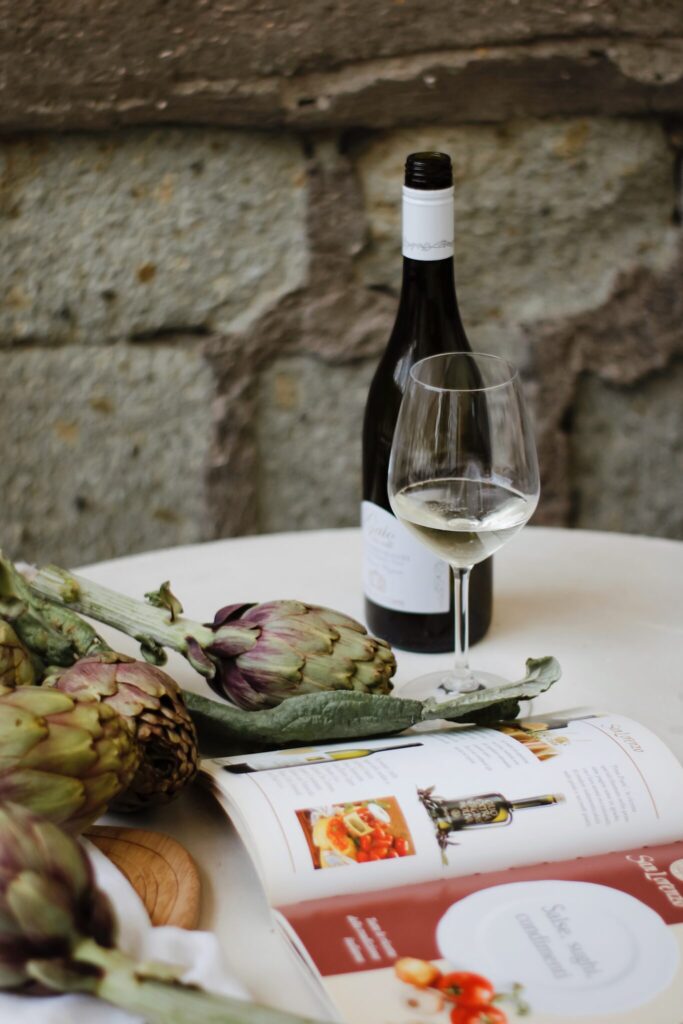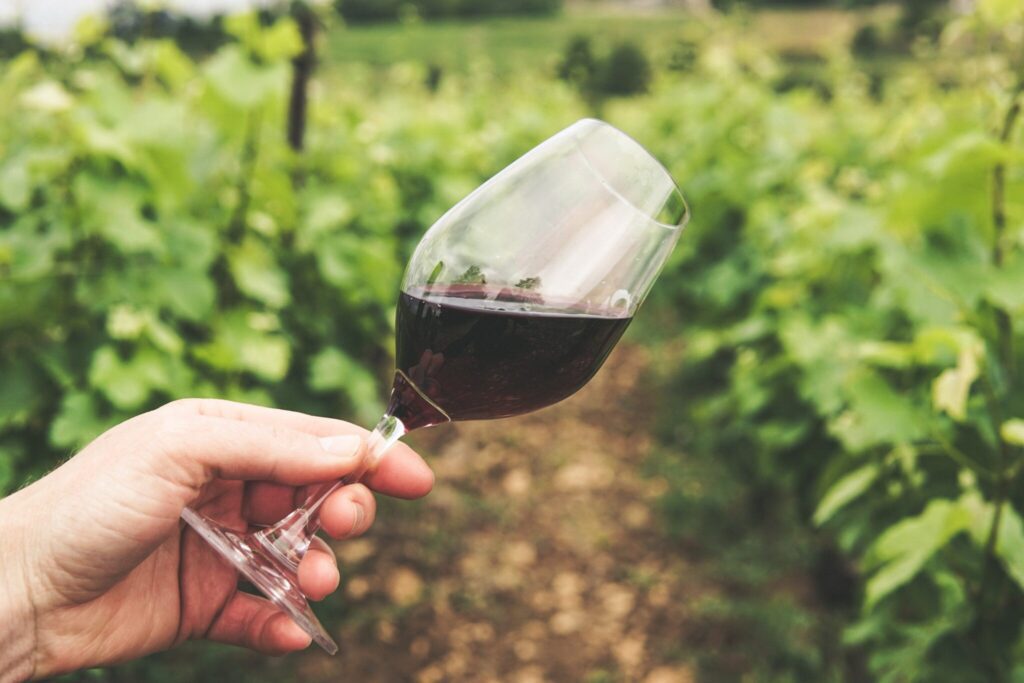Workation » Best Workation Locations and Why You Should Visit Them » Italy Workation – Working and Vacationing in Italy » What to Eat and Where in Italy » Popular Italian Wines to Enjoy During Workation
Popular Italian Wines to Enjoy During Workation
Italian wine is renowned all over the world for its quality, variety, and rich history. From the rolling hills of Tuscany to the sunny shores of Sicily, Italy is home to some of the oldest and most prestigious wine regions in the world. In this article, we will explore the unique and significant aspects of Italian wine, including its ingredients, location, sea, climate, and culture.

Ingredients
Italian wine is made from a wide variety of grapes, ranging from the well-known Sangiovese to the lesser-known Aglianico. Many of these grapes are indigenous to Italy and are grown nowhere else in the world. In addition to its native grapes, Italy also produces wine from international varieties such as Cabernet Sauvignon and Chardonnay, which have been introduced in recent decades.
Location
Italy’s wine regions are located throughout the country, from the hills of Piedmont in the north to the islands of Sicily and Sardinia in the south. Each region has its own unique terroir, or combination of climate, soil, and topography, which gives its wines a distinct flavor and character. Some of the most famous wine regions in Italy include Tuscany, Piedmont, Veneto, and Sicily.
Sea
Italy’s long coastline and proximity to the Mediterranean Sea have had a significant impact on its wine production. Coastal regions such as Liguria, Campania, and Sicily are known for their crisp, aromatic white wines. In contrast, inland regions such as Tuscany and Piedmont produce some of Italy’s most famous red wines. The sea breeze and warm temperatures in coastal regions also create ideal conditions for grape growing, leading to some of Italy’s most prized vineyards.
Climate
Italy’s diverse climate is another significant factor in its wine production. The country’s northern regions have a continental climate, with cold winters and warm summers, while its southern regions have a Mediterranean climate, with mild winters and hot summers. This range of climates allows Italy to produce a wide variety of wine styles, from full-bodied reds to light, crisp whites.
Culture
Wine has been a part of Italian culture for thousands of years, dating back to the Etruscans and the ancient Greeks. These people first introduced grape growing to the Italian peninsula. Today, wine is an integral part of Italian cuisine and daily life. Italians are known for their love of food and wine, and meals are often enjoyed slowly and with meticulous care. Wine is seen as a way to enhance the flavors of food and bring people together, making it an essential part of Italian culture.
In addition to its cultural significance, Italian wine has also had a significant impact on the global wine industry. Italian winemakers are known for their innovation and dedication to quality, leading to the development of various grape varieties and wine styles. Italy is also home to some of the most prestigious wine academies and schools in the world. In these schools, aspiring winemakers can learn the craft from some of the most renowned in the business.
Italian wine is an essential and significant aspect of Italian culture and cuisine. Its diverse ingredients, location, sea, climate, and culture have all contributed to the rich history and variety of Italian wine. Whether you are a wine enthusiast or simply enjoy an enjoyable glass of vino with dinner, Italy has something to offer everyone. From the full-bodied reds of Tuscany to the crisp whites of Sicily, Italian wines are known for their depth, complexity, and rich history. Here are the top 12 wines to enjoy locally in Italy, including their ingredients, location, sea, climate, and cultural significance.

1. Chianti
Chianti is a red wine made from the Sangiovese grape, which is grown primarily in the Tuscany region of Italy. Chianti is known for its fruity and floral aromas, as well as its dry and full-bodied flavor. It is an ideal pairing for red meat dishes and hearty pasta dishes.
Chianti wine is one of the most well-known and popular wines in the world, hailing from the beautiful region of Tuscany, Italy. The wine is made from the Sangiovese grape, which is grown primarily in the Chianti region of Tuscany. The wine is characterized by its dry, full-bodied flavor and strong tannins, which make it an ideal pairing for rich, meaty dishes. You can often find Chianti in your local supermarkets.
One of the reasons why Chianti wine is so popular is its long and storied history. The Chianti region has been producing wine for centuries, dating back to the 13th century. Wine has played a significant role in the cultural and social fabric of the region, and it has been enjoyed by locals and visitors alike for generations.
A further factor contributing to the popularity of Chianti wine is its unique flavor profile. The wine is known for its rich, complex flavors, which are derived from the soil, climate, and grape varietals of the region. Chianti wine typically has notes of cherry, raspberry, and plum, as well as hints of leather, tobacco, and earthy spices. The wine is aged in oak barrels, which gives it a smoky, woody flavor that adds to its depth and complexity.
Chianti wine is also versatile and can be paired with a wide range of foods. The wine’s bold and tannic flavor makes it an ideal pairing for rich, meaty dishes such as steak or lamb chops. However, it can also be paired with pasta dishes, pizzas, and even vegetarian dishes. The wine’s acidity helps to cut through the richness of these foods, enhancing their flavors and providing a well-rounded dining experience.
Another factor that contributes to the popularity of Chianti wine is its accessibility. Chianti wine is available at a wide range of price points, making it accessible to wine enthusiasts of all levels. The wine is also widely available in wine shops and restaurants around the world, making it easy to find and enjoy no matter where you are. In addition to its flavor profile and accessibility, Chianti wine is also a symbol of Italian culture and tradition. Wine is deeply ingrained in the cultural fabric of Tuscany, and it is often enjoyed during celebrations and special occasions. Drinking Chianti wine is a way to connect with the rich history and traditions of the region. It is a way to experience the unique flavors and aromas of Italy.
The popularity of Chianti wine is also due in part to its association with quality. The Chianti region has strict regulations governing the production of wine, including the types of grapes that can be used and the aging process. This ensures that only the highest quality wines are produced, and it gives consumers confidence in the quality of the wine they are drinking.
2. Barolo
Barolo is a red wine made from the Nebbiolo grape, which is grown in the Piedmont region of Italy. Barolo is known for its deep ruby color, complex aromas of cherries, and full-bodied flavor. It is an ideal pairing for rich, meaty dishes such as beef stew or lamb chops.
One of the reasons why Barolo wine is so popular is its long and storied history. Wine has been produced in the Piedmont region for centuries, and it has played a crucial role in the cultural and social fabric of the region. The wine is named after the small town of Barolo, which is located in the heart of the Piedmont region. It has become synonymous with the high quality and rich flavor that are characteristic of wines from this region.
The wine is characterized by its complex aromas and flavors, which are derived from the soil, climate, and grape varietals of the region. Barolo wine typically has notes of dark cherry, blackberry, and plum, as well as hints of tobacco, leather, and spices. The wine is aged in oak barrels, which gives it a smoky, woody flavor that adds to its depth and complexity. Barolo wine is also versatile and can be paired with a wide range of foods. The wine’s bold and tannic flavor makes it an ideal pairing for rich, meaty dishes such as steak, game meats, or slow-cooked stews. It also pairs well with strong, pungent cheeses and savory appetizers. The wine’s acidity helps to cut through the richness of these foods, enhancing their flavors and providing a well-rounded dining experience.

Another factor that contributes to the popularity of Barolo wine is its exclusivity. The wine is produced in limited quantities and is highly sought-after by wine enthusiasts around the world. This exclusivity gives the wine a sense of luxury and sophistication, and it makes it a prized possession for collectors and connoisseurs.
A symbol of Italian culture and tradition, Barolo wine also stands out for its exclusivity. Wine is deeply ingrained in the cultural fabric of Piedmont, and it is often enjoyed during celebrations and special occasions. Drinking Barolo wine is a way to connect with the rich history and traditions of the region. It is a way to experience the distinct flavors and aromas of Italy.
3. Amarone
Amarone is a red wine made from a blend of grapes, including Corvina, Rondinella, and Molinara, which are grown in the Veneto region of Italy. Amarone is known for its rich, complex flavor, which is the result of the special drying process that concentrates the grape sugars. It is an ideal pairing for strong cheeses and chocolate desserts.
5. Brunello di Montalcino
Brunello di Montalcino is a red wine made from the Sangiovese grape, which is grown in the Montalcino region of Tuscany. Brunello di Montalcino is known for its intense aromas of black cherry and leather, as well as its dry, tannic flavor. It is an ideal pairing for grilled meats and rich pasta dishes.

4. Prosecco
Prosecco is a sparkling wine made from the Glera grape, which is grown in the Veneto and Friuli-Venezia Giulia regions of Italy. Prosecco is known for its light, fruity flavor and refreshing bubbles. It is an ideal pairing for seafood dishes and light, fresh salads.
6. Moscato d'Asti
Moscato d’Asti is a sweet white wine made from the Moscato grape, which is grown in the Piedmont region of Italy. Moscato d’Asti is known for its light, sweet flavor and refreshing bubbles. It is an ideal pairing for fruit-based desserts and spicy foods.
7. Barbaresco
Barbaresco is a red wine made from the Nebbiolo grape, which is grown in the Piedmont region of Italy. Barbaresco is known for its complex aromas of dried fruit and flowers, as well as its full-bodied flavor. It is an ideal pairing for hearty meat dishes and aged cheeses.
8. Nero d'Avola
Nero d’Avola is a red wine made from the Nero d’Avola grape, which is grown primarily in the Sicily region of Italy. Nero d’Avola is known for its intense flavor, with notes of dark fruit and spice. It is an ideal pairing for grilled meats and hearty pasta dishes.
9. Soave
Soave is a white wine made from the Garganega grape, which is grown in the Veneto region of Italy. Soave is known for its crisp, refreshing flavor and subtle floral notes. It is an ideal pairing for seafood dishes and light appetizers.
10. Vermentino
Vermentino is a white wine made from the Vermentino grape, which is grown primarily in the Liguria and Sardinia regions of Italy. Vermentino is known for its light, crisp flavor and subtle citrus notes. It is an ideal pairing for seafood dishes and light salads.
11. Nebbiolo
Nebbiolo is a red wine made from the Nebbiolo grape, which is grown primarily in the Piedmont region of Italy. Nebbiolo is known for its complex aromas of dried fruit, flowers, and spices, as well as its strong tannins and full-bodied flavor. It is an ideal pairing for rich, meaty dishes such as beef stew or roasted pork.
Italian wines are not only delicious, but they also reflect the unique cultural and historical significance of each region where they are produced. The wine-making tradition in Italy dates back thousands of years, and it has been influenced by the various cultures and civilizations that have passed through the country over time. The diverse terrain and climate of Italy make it an ideal location for growing a wide range of grape varieties, each with its own unique flavor and aroma. In addition to the popular wines mentioned above, Italy is also known for its many regional specialties. For example, the Piedmont region is famous for its Barolo and Barbaresco wines, as well as its sweet Moscato d’Asti. The Tuscany region is known for its Chianti and Brunello di Montalcino wines, while the Veneto region is famous for its Prosecco and Soave wines.
Italian wines are also often paired with local cuisine, which reflects the unique flavors and ingredients of each region. For example, the bold and tannic red wines of Tuscany are frequently paired with rich, meaty dishes such as Bistecca alla Fiorentina (Florentine-style steak), while the light and refreshing Prosecco wines of Veneto are often associated with fresh seafood and delicate salads.
Italian wine is an integral part of the country’s culinary tradition and cultural heritage. Whether you are a wine connoisseur or simply a lover of tasty food and drink, Italy offers a wide range of wines that are sure to delight your taste buds and provide an unforgettable and memorable experience. So why not raise a glass of Italian wine and toast the rich and flavorful traditions of this beautiful country?
12. Sangiovese
Sangiovese is a red wine made from the Sangiovese grape, which is grown primarily in the Tuscany region of Italy. Sangiovese is known for its bold, full-bodied flavor and strong tannins. It is an ideal pairing for rich, meaty dishes such as grilled steak or lamb chops.

Find Where to Visit and What to Eat on Your Workation
For your Italy Workation, the right region to visit could make all the difference between enjoying your stay and finding your true work-life balance. Famous works of art and unforgettable ancient monuments meet incredible landscapes and traditional villages with histories spanning two thousand years. Look for the magnificent blue water, stroll through preserved medieval streets, and learn about the specific flavors helping create the unique vision of factors that make Italy.
Find the information you need to ensure you have the most memorable Italy Workation possible. Then, allow us to accelerate your productivity and maximize your experience with an authentic connection to Italy. Take one step closer to planning your Workation or learn more about What Festivals People Celebrate in Italy.
More articles on Italian food and drinks
- Foods Enjoyed by Locals in Northern Italy
- Discovering the Hidden Gems of Italian Cuisine During Your Workation
- Foods Enjoyed by Locals in Tuscany
- What to Eat and Where in Italy
- Foods Enjoyed by Locals in Rome
- Italian Coffee Culture Guide
- Popular Food Festivals in Italy
- Foods Enjoyed by Locals in Venice

